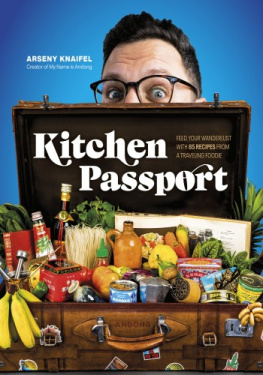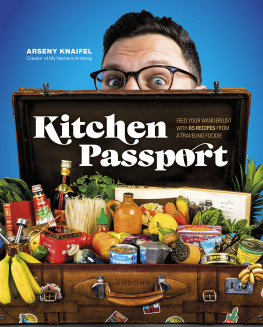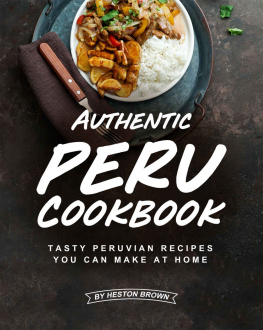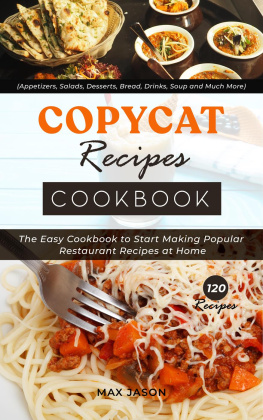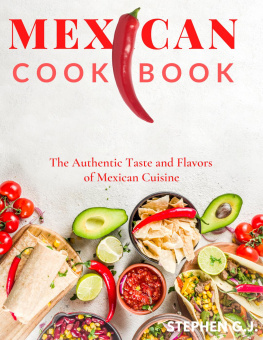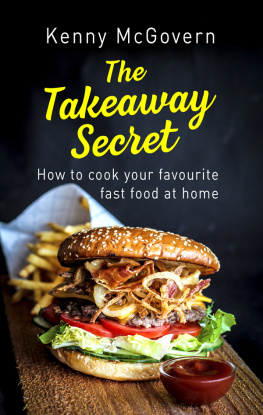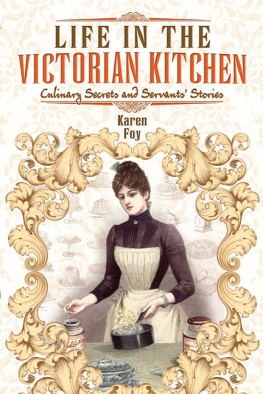g
How to use this eBook
Preferred application settings
For the best reading experience, the following application settings are recommended:
- Orientation: Portrait
- Color theme: White background
- Scrolling view: [OFF]
- Text alignment: Auto-justification [OFF] (if the eBook reader has this feature)
- Auto-hyphenation: [OFF] (if the eBook reader has this feature)
- Font style: Publisher default setting [ON] (if the eBook reader has this feature)
- In Settings, change the font size to a size you are most comfortable with.
- Double-tap image to see the details clearly.
CONTENTS
g
Introduction
Whats your favorite part about traveling? If you are holding this book in your hands, chances are we have the same preference: we travel for food.
It hasnt always been like that for me. I used to get out a map and plan my itinerary according to the sights and places I wanted to visit. My meals were afterthoughts and would have to be planned around my itinerary; sometimes a sloppily packed sandwich and a banana would do.
Over time, I did a full one-eighty. When I travel now, I look at food recommendations first. I will walk across entire cities to get to remote locations, get up early for the best breakfast spot in town, and queue for hours to grab iconic street food. If there is time in between to see some epic architectural monument, fine, Ill do it (if theres a good bakery nearby). The reason is not simply that I want to taste the foodits the whole experience of discovering it. And over time, I found yet another, even more passionate goal of mine: capture these moments of culinary adventure, get inspired by them, and find ways to re-create the moments Ive had along the way.
If there is one person I have to thank for my outlook on food, it is the late Anthony Bourdain. The first time I saw an episode of his TV show on a random longhaul-flight, I was simply blown away by how skillfully he used food to shape a narrative around a regions cultural essence and the human condition in general. That was when I decided to follow a similar path: I want to tell stories about the world and the people living in it through the lens of foodstories not just about what we eat, but about why we eat it and how we came to do so.
After spending over five years filming videos about food, some more ambitious than others, I am excited to present to you a collection of recipes, stories, and inspirations that I accumulated over the first few decades of my life as a self-proclaimed traveling foodie. There are a few things you should know, though.
AUTHENTICITY IS A MYTH
The more time I spend researching and re-creating food, the more I realize that many foodies spend a lot of energy on chasing authenticity. A fools errand, if you ask me.
Food has always been a living, breathing thing. We can see this historically as recipes adapt to the state of the world, to cultural and societal trends, to natural events and human migration. Just because someones grandma added a particular ingredient or you had it a certain way on your trip to Phuket back in 2002 does not make it more or less authentic.
I was once tasked with compiling a list of typical Berlin food. I guess people expected old-school German cooking, but instead the list featured dishes with Turkish or Vietnamese roots. Many people confronted me about it, but I firmly stood my ground. Most Berliners of my generation simply do not eat old-school German food on a daily basis. Kfte kebabs, pho, or pizza, on the other hand, end up on the menu weekly. But those are just newly introduced international foods, my critics would point out snarkily. To which all I can say is that even the humble potatoa staple of German cuisine, undisputed by even the most hardcore traditionalistswas a novelty from the far-off Kingdom of Peru less than two centuries ago.
The only definition of authenticity I will accept is this: its what people really eat. Nothing else matters.
EXPECT THE UNEXPECTED
With that out of the way, what can you expect to find in this book? Elaborate, meticulously reconstructed recipes? Not quite.
Its not that it wouldnt be possible to re-create street food and home-cooking classics from around the world somewhat successfully at home. Its just that it would be a lot of work, and yet it would be missing the point. Even if you went through all the trouble of sourcing exotic ingredients and gathering highly specialized tools, in my view, youd still not be able to live up to the original. It wouldnt be your faultits just that slurping a bowl of noodles from a plastic bowl while sitting on a tiny stool in a Taiwanese night market with all its sounds and smells will never be the same as doing so in your home kitchen. But that doesnt have to be a bad thing!
Instead, I am trying to find nuggets of inspiration within the eating experiences Ive had around the world. Is there a certain technique, a philosophy, a flavor combination, or a presentation style that we can learn from and repurpose? For the most part, the recipes I have developed for this book are just that: simple demonstrations of a cooking concept worth drawing inspiration from. Some stay fairly close to the traditional recipes they are meant to resemble, and some are wild, almost heretic interpretations.
Next to travel-inspired recipes, I will also not pass up this opportunity to introduce you to a few classics from German and Russian/Soviet cuisine, which shaped me in major ways as I was growing up.
COME FOR THE RECIPE, STAY FOR THE STORY
I always emphasize the value of storytelling in food, whether its one of the countless incredible food origin stories I like to feature on my channel or a personal memory or experience associated with a certain dish or flavor.
This is why, embedded into each chapter, you will find a little essay or story inspired by my own food travels. Many of those will reference my time in China. Its not that I prefer Chinese cuisine to others (although sometimes, I might). Its just that Chinese culture used to be completely foreign to me, but the years I spent studying, working, and living there made it something of a home away from home. Without a doubt, food was my catalyst to learning about China, a means of bonding with local friends, and my ticket to understanding a whole new culture. It could have been any other countryits more of a testament to the power of food as a social lubricant.
ONE FINAL NOTE
If you look at the ingredient lists in this book, you will quickly notice that I liberally recommend using MSG in home cooking. If this bothers you, relax. I am not a scientist, so I will not try to convince you to stop worrying about using small amounts of MSG in home cooking. Feel free to replace it with chicken bouillon powder (which itself probably contains MSG), use a 1:1 mix of sugar and salt, or leave it out entirely. I personally find it to be a fantastic shortcut for home cooks who dont have all day. My golden rule: dont use MSG to make bad food taste good; use MSG to make good food taste even better.
With all of these things out of the wayif youre readylet me take you on a culinary journey around the world!
g
Essential Tools
There are a few kitchen tools I absolutely could not live without. Let me share some common classics as well as hidden champions you should have at hand.
Kitchen Scale
This is not optional. If you are serious about cooking (especially if you like following recipes), there is no way around getting a kitchen scale. I would even recommend getting two: a regular scale for most weighing tasks as well as a small precision scale for measuring things like salt or yeast down to a tenth of a gram.
Knives
I dont have to tell you how important a knife is in the kitchen. My personal collection is quite large, but the types I end up using the most are always the same: a large, heavy Chinese-style cleaver; a medium-sized chefs knife or santoku knife; and a small but chunky paring knife. With these three, you will be able to get nearly everything done in the kitchen.
Next page
